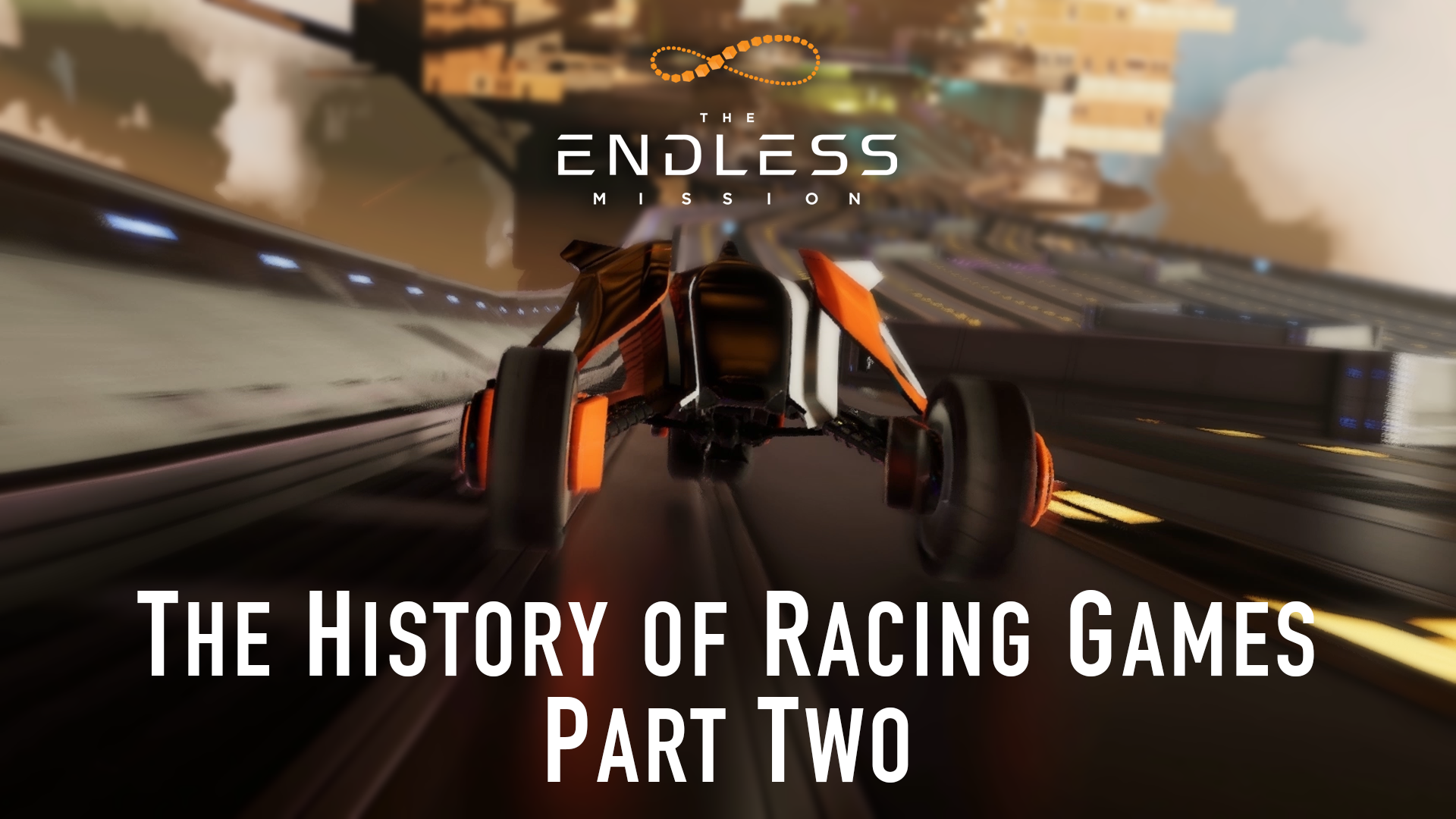
Welcome back, racers! When we last left off in our overview of racing games, Nintendo had just released Super Mario Kart, changing the landscape of racing games forever.
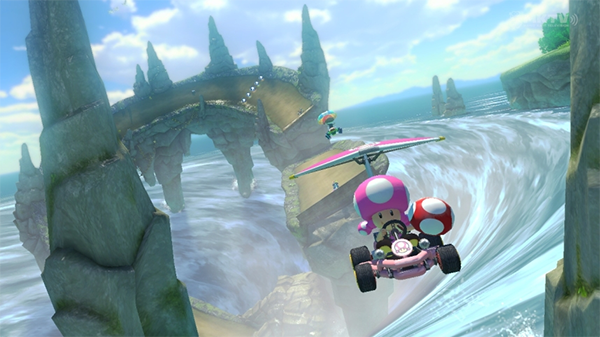 And seascape. And skyscape. And…
And seascape. And skyscape. And…Racing games had been finding ways to vary themselves to stand out from the crowd long before Mario Kart came onto the scene, whether it was via unique vehicles (spaceships, snowboarding, roller skating) or gameplay elements (vehicle combat, non-linear tracks, platformer mechanics), but they were all generally content to just share the label of “racing game”. After Super Mario Kart, however, it became abundantly clear that the racing genre was splitting up into several distinct sub-genres, each starting to be championed by franchises rather than single games. For this article, we’ll be looking at each sub-genre independently, explaining what makes them unique and what games best exemplify their playstyles. Let’s ride!
Racing Simulators: Everything Except the Traffic Jams and Gas Prices
By the early 90s, video game technology had gotten advanced enough that developers could focus on not just making racing games, but realistic racing games. These games will take factors like friction, aerodynamics, and weather into consideration to make sure the vehicles behave as realistically as possible. They can even require you to keep track of things such as fuel levels or tire condition, with dire consequences if you don’t pull over to the pit stop to tend to these in time. As a general rule of thumb: In most other racing games, it’s usually assumed that you’ll keep your foot on the gas at all times and rarely, if ever, use the brakes. Try that in a racing sim, and expect to see your car flip over five seconds in and slam into a barrier in lovingly-rendered detail.
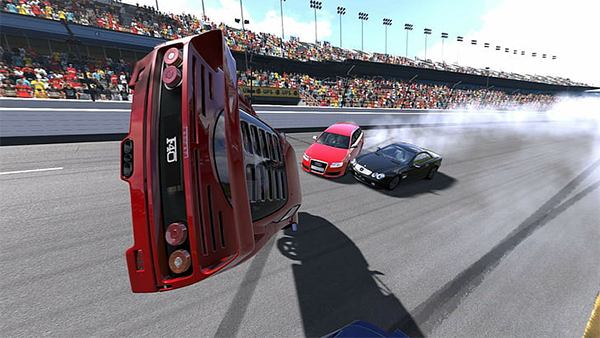 Which, to be fair, probably IS the appeal to some people.
Which, to be fair, probably IS the appeal to some people.These games, far more than the other racing sub-genres, also take pride in how how realistic they
look as well, taking great pains to create photorealistic recreations of real world racetracks and working with automotive manufacturers directly to make sure that their cars are portrayed accurately in game. Because the focus on realism usually results in a notoriously high difficulty curve (and you often need quite a beefy PC to even run these kinds of games to begin with), racing sims tend to have a pretty niche audience compared to the other two major sub-genres, with one notable exception that we’ll get to in a moment.
We already discussed the first true racing simulation game last week with Geoff Crammond’s REVS, released in 1984. The first game to
popularize it, however, was 1989’s Indianapolis 500: The Simulation, created by Papyrus Design Group. This game strived to be as accurate a recreation of the 1989 Indianapolis 500 race as possible at the time (right down to the same qualifying order as the real race), and any changes the player made to their car would noticeably alter its performance. This was the first game to really establish racing sims as being wholly unique from other kinds of racing games before Mario Kart would necessitate the need for sub-genres.
In 1991, the first racing sim on a console would appear in the form of Human Entertainment’s Fastest 1 for the Sega Genesis, while 1992 (the same year as good ol’ Super Mario Kart) saw Geoff Crammond back in the driver’s seat to create Formula One Grand Prix, which became popular enough that entire racing leagues emerged where people would compare their race times to other drivers. Meanwhile, Papyrus Design Group showed no signs of slowing down, releasing several additional racing sims during this time. Their biggest contribution would undoubtedly be NASCAR Racing in 1994, the first
online racing game (of any sub-genre). The ability to actually race others across the globe ushered racing sims into a whole new era.
 Any rumors regarding the true owner of Papyrus Design Group are, of course, completely unfounded.
Any rumors regarding the true owner of Papyrus Design Group are, of course, completely unfounded.In 1997, the Racing Sim world would be taken completely by storm with the arrival of Gran Turismo. Designed by Kazunori Yamauchi exclusively for the PlayStation console, it went on to become the best-selling game on the console and is still the highest-rated racing game
of all time. Gran Turismo didn’t just prove that racing simulations could succeed on consoles, it proved that they could become mainstream, household names despite their notorious difficulty. Gran Turismo would go on to become a flagship franchise for the PlayStation, having a major release on almost every console they’ve made since and becoming PlayStation’s highest-selling exclusive franchise. It even managed to secure a Guinness World Record for the largest number of cars in a single racing game with 2013’s Gran Turismo 6 (1,237 total, for those curious).
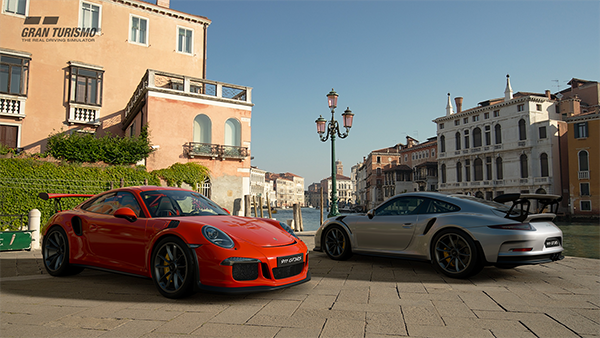 No, that’s not a photograph. I was NOT joking when I said these games take pride in their realism.
No, that’s not a photograph. I was NOT joking when I said these games take pride in their realism.There have been many other racing sims created since Gran Turismo, of course - the franchise is a PlayStation exclusive, after all, so folks on other platforms need to get their fix elsewhere. Notable examples include Papyrus’ (yes, them again) Grand Prix Legends in 1998, ISI’s rFactor in 2005, Kunos Simulazioni’s Assetto Corsa in 2010, and Slightly Mad Studios’ Project CARS in 2015.
Kart Racing: Where Road Rage is Encouraged
When Super Mario Kart launched, it inspired countless other games that sought to copy its unique formula. Most of these games were written off as “Mario Kart Clones” at first, but much in the same way that “Doom Clone” eventually gave way to the creation of the First-Person Shooter genre, these games too eventually inspired the less-dismissive label of the Kart Racer.
Now to be fair, even the new label of Kart Racer was a bit of a misnomer. These games don’t always have go-karts as their primary vehicles - even Mario Kart itself has since started including other options such as motorbikes and ATVs! The real key distinction for this sub-genre is the gameplay and presentation: Tracks are more akin to roller coasters than race courses, with obstacles far beyond the barriers on the sides of the track peppered throughout. Physics take a back seat to spectacle, and players get over-the-top items or weapons that they can use to actively hinder opponents rather than just trying to outrace them. Controls are usually simplified to gas/brakes, steering, using items, and some form of drifting for tight corners. In this genre, the in-game drivers are typically highlighted far more than the cars - you’re not racing in a Ferrari or a Porsche, you’re racing as Mario or Crash Bandicoot or Spongebob Squarepants (it probably goes without saying that this is a very popular genre for licensed properties). In short, kart racing focuses on chaotic fun, not realism or pure skill. This makes them very popular among both younger and casual gamers, as even the worst player is just one power-up away from pulling off a come-from-behind victory.
 “Now I am become Death, the destroyer of worlds.” - Your Little Brother in 8th Place
“Now I am become Death, the destroyer of worlds.” - Your Little Brother in 8th PlaceAs has been repeatedly established at this point, this specific sub-genre was officially kicked off by the release of Super Mario Kart in 1992, and the Mario Kart franchise has remained the reigning king of this kind of racing game ever since. Consistency and polish are their keys to success in this department: While each Mario Kart game brings something new to the table - 1996’s Mario Kart 64 was in full 3D, 2003’s Mario Kart: Double Dash!! put two characters in a single kart, 2008’s Mario Kart Wii introduced bikes and motion controls, etc. - at the end of the day, it’s still the same Mario Kart experience people come to expect, just with new characters, karts, and tracks. However, by keeping each release tied to a specific console (you’ll never see two new Mario Kart games on the same Nintendo system) as well as being… well…
just that good, people are always more than happy to welcome the franchise like an old friend when it returns. This has resulted in every new entry in the franchise becoming one of, if not
the, top-selling games on that system.
Many companies were quick to jump on the bandwagon after Nintendo’s success, and while none of them have ever matched Mario Kart in critical or commercial success, there’s nonetheless plenty of notable examples among them. Perhaps unsurprisingly, the first franchise to follow Mario’s footsteps was his old rival, Sonic the Hedgehog. Sonic Drift was released on the Game Gear in 1994, less than two years after Super Mario Kart. Sonic would go on to have probably the most varied kart racing history, dabbling with all sorts of different vehicles in a racing career almost as long as Mario’s: He’d race on foot in 1997’s Sonic R, use a hoverboard in 2006’s Sonic Riders, and swap between land, sea, and air vehicles on the fly in 2012’s Sonic & All-Stars Racing Transformed.
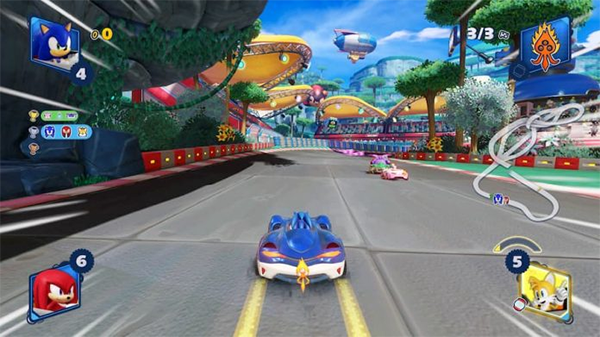 And to answer the question asked by every. Single. Reviewer: He races in a car as a handicap. If he raced on foot, it’d be unfair to everyone else.
And to answer the question asked by every. Single. Reviewer: He races in a car as a handicap. If he raced on foot, it’d be unfair to everyone else.Other fondly remembered games in this sub-genre include Diddy Kong Racing in 1997, and Crash Team Racing in 1999. Both of these games included a single-player adventure mode where, in between races, you could drive around an open world, interacting with other characters, partaking in side missions, and collecting various doo-dads to unlock new content. 1999 also saw the release of Lego Racers, while 2010 gave us ModNation Racers. Both of these games combined kart racing with something very near and dear to our hearts: User Generated Content. We’ll be coming back to these games in more detail next week, but they’re definitely worth noting now.
Arcade Racing: Don’t Call it a Comeback, We’ve Been Here the Whole Time
With racing sims focusing on realism at the expense of simplicity, and Mario Kart and its ilk fully embracing chaos and randomness, the racing games that had been here all along suddenly found themselves in a strange middle ground. They wanted to replicate the thrill of racing, but not worry about the minute details. They wanted to award skill over luck, but not have a high barrier of entry. These games opted to simply continue doing what they’ve always been doing and, thanks to their origins in the arcade, were given the moniker Arcade Racers.
Arcade Racers combine the pick-up-and-play nature of Kart Racers with the overall presentation of Racing Sims. The driving controls are usually a bit more involved than in Kart Racers (manual transmissions will almost always be an option, for instance), but the physics are far more forgiving than they would be in a Racing Sim - you’ll rarely ever spin out of control from taking a turn too hard, and concerns like tire wear or weather conditions are a non-issue. Courses tend to be set in more exotic locations than real-world racetracks, but never as wild as the ones seen in Kart Racers. The vehicles can be cars, both licensed or fictional, or something more fantastical such as motorboats (Midway’s Hydro Thunder) or spacecraft (Nintendo’s F-Zero). Power-ups that can assist you or hinder opponents can exist, but are almost never randomized, allowing for far more strategy and skill when using them.
As you might have gathered by now, there can be a lot of overlap between Arcade Racers and Kart Racers, meaning it can sometimes be hard to tell if a racing game qualifies for one sub-genre or another (Racing Sims adhering to reality so hard makes them far more self-contained). A good question to ask when trying to figure this out: How much luck is involved? In Arcade Racers, skill is highly favored, with the best overall driver usually being the winner, and randomness is rarely a factor. If weapons or power-ups are involved at all, they are accessible by the same players at the same time, meaning they can be planned ahead for and their threat minimized. Thus, if the answer to that question of randomness is “there’s very little”, then you’re probably looking at an Arcade Racer, regardless of presentation or platform.
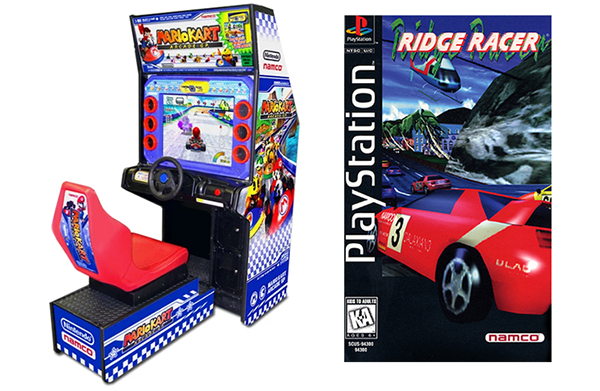 The one on the left is an arcade game, but is actually a Kart Racer. The one on the right is a console game, but it’s really an Arcade Racer. Got it?
The one on the left is an arcade game, but is actually a Kart Racer. The one on the right is a console game, but it’s really an Arcade Racer. Got it?After the release of Super Mario Kart 1992, one of the first major Arcade Racers to come out was Sega’s Virtua Racing, released later in the same year. It wasn’t the first racing game to use 3D graphics (in addition to Plazmaline mentioned last week, there was also Namco’s Winning Run in 1998 and Atari’s Hard Drivin’ in 1989), but Virtua Racing was the first to really show what they could do for the racing genre, laying the foundations for future 3D racers.
In 1993, Namco would release Ridge Racer as a direct competitor to Virtua Racing, and 1994 would see the start of two more major Arcade Racer franchises: EA’s The Need for Speed and Midway’s Crusin’ USA. The former would even go on to become one of the top ten most successful video game series of all time, spawning over 20 games and even getting a film adaptation, of all things.
 Which was also the source of this reaction image. Yes, really.
Which was also the source of this reaction image. Yes, really.The late 90s and early 2000s saw many games of this sub-genre move to consoles. In the process, they also began experimenting with “free form” gameplay, where players weren’t confined to a single track but instead tasked with navigating an open world and hitting waypoints in a specific order faster than anyone else. Angel Studios’ Midtown Madness was the first game to introduce this concept on PCs in 1999, while they would eventually bring the same kind of gameplay to consoles in 2000 with Midnight Club: Street Racing. Microsoft would throw their hat in the ring with the Forza series starting in 2005. Forza is unique in that the franchise regularly alternates between
both kinds of Arcade Racing styles: Forza Motorsport for track racing, and Forza Horizon for open-world racing.
Conclusion
And with that, our overview of the history of racing games is complete! From its origins as a surprisingly unsuccessful Atari game to the creation of three major sub-genres all with massive franchises, it’s certainly come a long way. However, we’re not quite done yet! There are a number of racing games that have experimented with user-generated content, a topic quite relevant to The Endless Mission. Next week, we’ll be looking at those specific games in far more detail to see how they directly inspired us when incorporating racing into our editor! Keep those engines revving - we’ll see you next week!
https://store.steampowered.com/app/827880/The_Endless_Mission/
Image Sources: knowyourmeme, mpamusement, gamespew, denofgeek, gran-turismo.com, weheartit, wallpaperflare, telegraph


 And seascape. And skyscape. And…
And seascape. And skyscape. And… Which, to be fair, probably IS the appeal to some people.
Which, to be fair, probably IS the appeal to some people. Any rumors regarding the true owner of Papyrus Design Group are, of course, completely unfounded.
Any rumors regarding the true owner of Papyrus Design Group are, of course, completely unfounded. No, that’s not a photograph. I was NOT joking when I said these games take pride in their realism.
No, that’s not a photograph. I was NOT joking when I said these games take pride in their realism. “Now I am become Death, the destroyer of worlds.” - Your Little Brother in 8th Place
“Now I am become Death, the destroyer of worlds.” - Your Little Brother in 8th Place And to answer the question asked by every. Single. Reviewer: He races in a car as a handicap. If he raced on foot, it’d be unfair to everyone else.
And to answer the question asked by every. Single. Reviewer: He races in a car as a handicap. If he raced on foot, it’d be unfair to everyone else. The one on the left is an arcade game, but is actually a Kart Racer. The one on the right is a console game, but it’s really an Arcade Racer. Got it?
The one on the left is an arcade game, but is actually a Kart Racer. The one on the right is a console game, but it’s really an Arcade Racer. Got it? Which was also the source of this reaction image. Yes, really.
Which was also the source of this reaction image. Yes, really.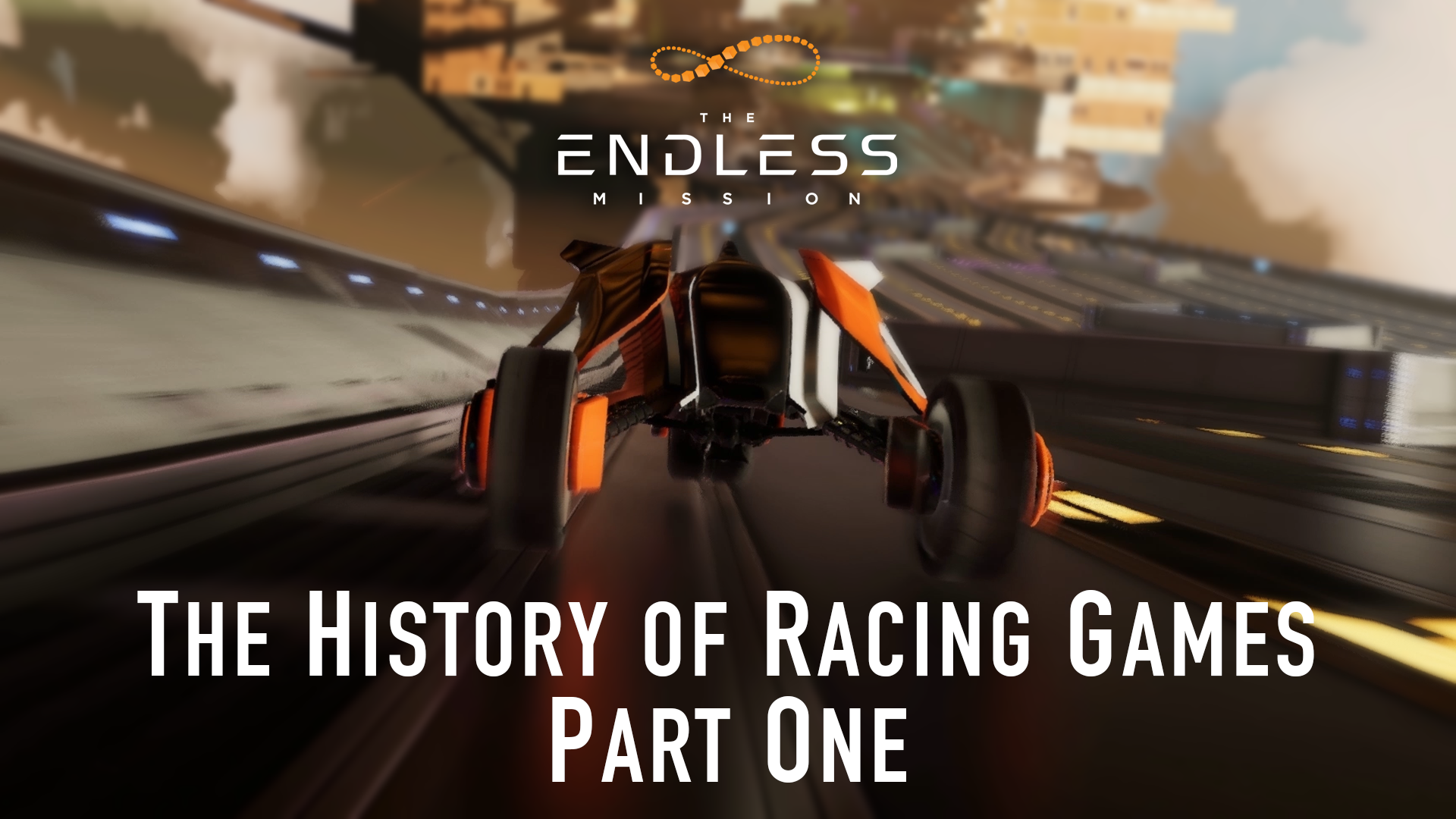
 … Eh, I’m used to it. I get the same response when I go home for the holidays.
… Eh, I’m used to it. I get the same response when I go home for the holidays. This advertising flyer for the game is so 70s, my cargo pants turned into bellbottoms just looking at it.
This advertising flyer for the game is so 70s, my cargo pants turned into bellbottoms just looking at it. Artist’s Rendition
Artist’s Rendition The ad was still hilariously 70s, though. Don’t worry about that.
The ad was still hilariously 70s, though. Don’t worry about that. Eeeeeeey…
Eeeeeeey…  The first controversial video game, and certainly not the last.
The first controversial video game, and certainly not the last. If Space Race invented racing games, this vibrantly colored classic defined it.
If Space Race invented racing games, this vibrantly colored classic defined it.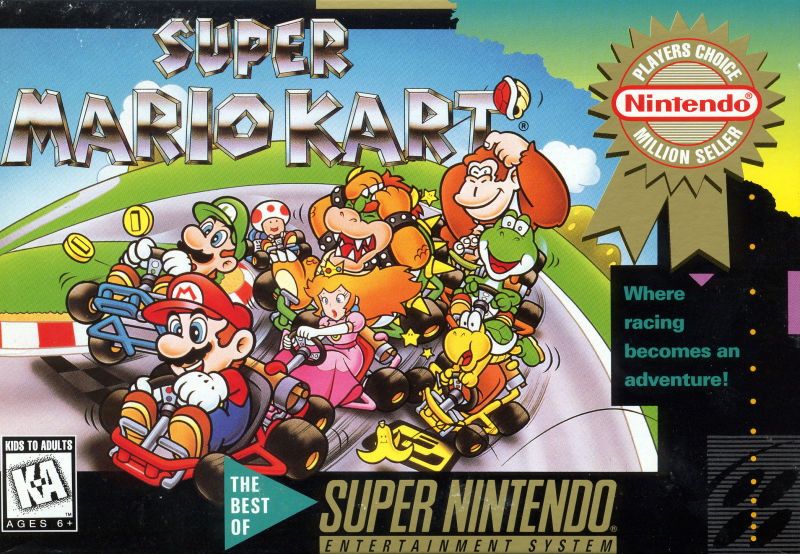 It’s-a me! The game you were all thinking of when you first started reading this!
It’s-a me! The game you were all thinking of when you first started reading this!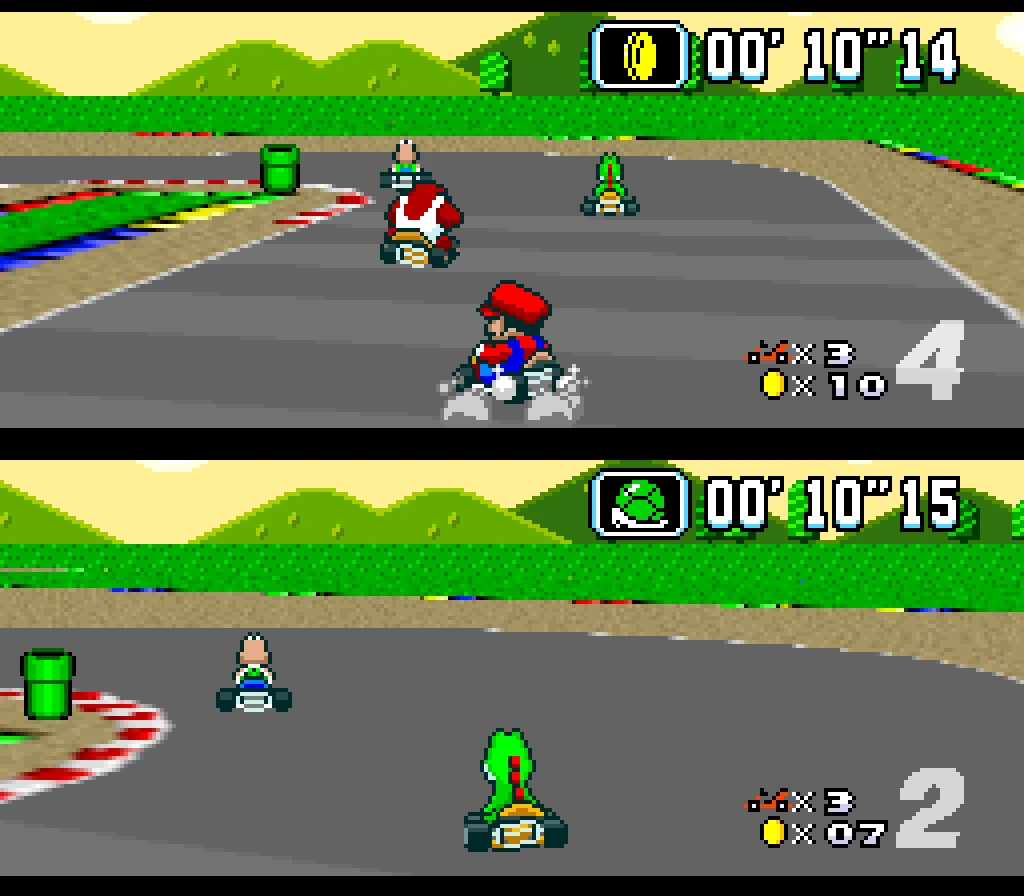 I swear to Miyamoto, if you even so much as LOOK at me with that Red Shell…
I swear to Miyamoto, if you even so much as LOOK at me with that Red Shell… And hilarious memes. Can’t forget those.
And hilarious memes. Can’t forget those.